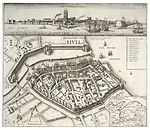Ye Olde White Harte
Buildings and structures completed in the 1660sGrade II* listed buildings in the East Riding of YorkshireGrade II* listed pubs in EnglandHistoric buildings in Kingston upon HullUse British English from January 2023

Ye Olde White Harte is a public house in Hull, England. It was built around 1660 in the Artisan Mannerist style but did not become a pub until the 1730s. In the aftermath of the Glorious Revolution of 1688 it was the site of a successful plot to remove the Catholic Governor of Hull. The pub was remodelled in 1881 in the Romantic style with extensive alteration to the interior and façade. At least two residents have suffered fatal accidents in the pub and it is reputed to be "one of Hull's most haunted".
Excerpt from the Wikipedia article Ye Olde White Harte (License: CC BY-SA 3.0, Authors, Images).Ye Olde White Harte
Silver Street, Hull Old Town
Geographical coordinates (GPS) Address Nearby Places Show on map
Geographical coordinates (GPS)
| Latitude | Longitude |
|---|---|
| N 53.742944444444 ° | E -0.33352777777778 ° |
Address
Relish
Silver Street 27
HU1 1JG Hull, Old Town
England, United Kingdom
Open on Google Maps








